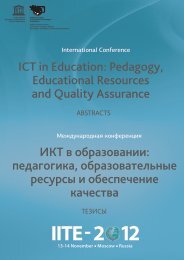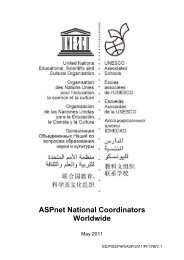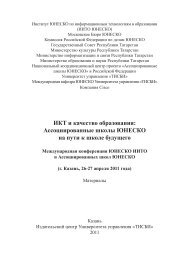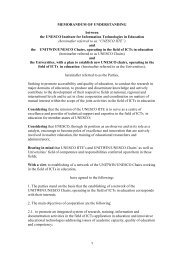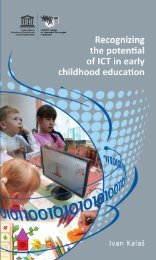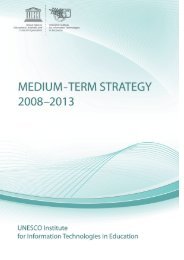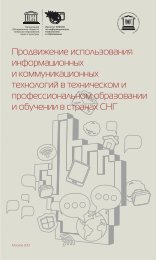UNESCO ICT Competency Framework for Teachers ... - unesco iite
UNESCO ICT Competency Framework for Teachers ... - unesco iite
UNESCO ICT Competency Framework for Teachers ... - unesco iite
Create successful ePaper yourself
Turn your PDF publications into a flip-book with our unique Google optimized e-Paper software.
<strong>UNESCO</strong> <strong>ICT</strong> <strong>Competency</strong> <strong>Framework</strong> <strong>for</strong> <strong>Teachers</strong><br />
16<br />
Modular structure<br />
IMPLEMENTATION<br />
Countries wanting to use the <strong>UNESCO</strong> <strong>Framework</strong> may wish to start by conducting<br />
a baseline study of the current <strong>ICT</strong> competency levels of teachers, <strong>for</strong> example<br />
through an examination or questionnaire based on the examples of syllabi and<br />
exam specifi cations provided in Appendix 2. Such a study would help to indicate<br />
which of the three <strong>ICT</strong>-CFT approaches would be the most relevant and would<br />
identify priorities <strong>for</strong> providers of teacher education and professional learning.<br />
The <strong>ICT</strong>-CFT is meant to be used in a modular fashion. Teacher-education institutions and providers of professional<br />
learning do not need to address all the modules and competencies in any particular course or learning activity.<br />
Rather, they can design off erings that address only certain modules but are nonetheless consistent with the<br />
overall goals and rationale of the <strong>Framework</strong>. This means that courses and professional learning activities should<br />
not consist of a small number of disconnected competencies. There should be a clear rationale <strong>for</strong> the modules<br />
selected. The selection might be based on a rationale of breadth, in which all of the modules <strong>for</strong> one approach<br />
are addressed. A rationale of depth could select the same module, <strong>for</strong> example Pedagogy, in each of the three<br />
approaches. A role rationale could select those modules which were particularly relevant <strong>for</strong> certain roles, such<br />
as technology coordinators, curriculum coordinators, or principals. Other types of rationale and patterns are also<br />
possible.<br />
Future improvements<br />
While the current set of competencies is meant to be comprehensive, the <strong>ICT</strong>-CFT is intended to be an evolving<br />
framework. It will be periodically reviewed as <strong>ICT</strong> evolves and as new knowledge develops about educational<br />
processes and structures. Professional learning providers and teacher-educators are encouraged to off er<br />
suggestions to <strong>UNESCO</strong> on how the content, structure and review process of the <strong>Framework</strong> might develop.<br />
Development paths<br />
The TTISSA report 9 points out that teacher education programmes are often out of phase with development<br />
goals. The intent of the <strong>ICT</strong>-CFT is to provide education policymakers with policy objectives in the <strong>for</strong>m of<br />
new approaches to teaching. These policy objectives can be used to re<strong>for</strong>m teacher-education and profession<br />
learning to advance economic and social development.<br />
9 See p. 8<br />
4





